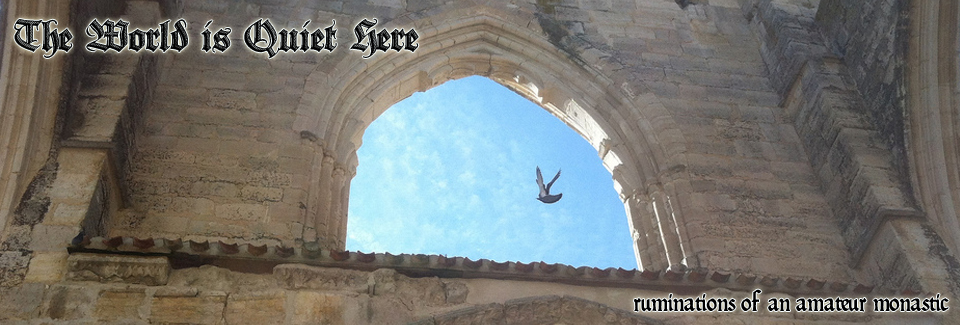The Ascension of the Lord

Viri Galilæi, quid admiramini aspicientes in cælum?
Mirroring the forty days of Lent, forty days have passed since Easter. For most of the world1 today is the Solemnity of the Ascension. Some dioceses, particularly in the United States and including my own Archdiocese of Seattle, have elected to transfer the celebration of this great feast to the following Sunday.
Of course, in these times of streaming Masses, there’s no reason you can’t participate in Ascension Day Masses on both days.

That moment when Christ ascended into heaven has to be one of the great comic scenes in the Bible:
As they were looking on, he was lifted up, and a cloud took him from their sight.
While they were looking intently at the sky as he was going, suddenly two men dressed in white garments stood beside them. They said, “Men of Galilee, why are you standing there looking at the sky? This Jesus who has been taken up from you into heaven will return in the same way as you have seen him going into heaven.”
(Acts 1:9-11)
Can you just imagine the Apostles standing and staring into the sky? And the angels bringing them back to earth? Or is it just me?
One of the more succinct descriptions of this day I’ve found has been copied all over the Internet, to the point where I’m unable to properly source it:

The Ascension of Our Lord, which occurred 40 days after Jesus Christ rose from the dead on Easter, is the final act of our redemption that Christ began on Good Friday. On this day, the risen Christ, in the sight of His apostles, ascended bodily into Heaven (Luke 24:51; Mark 16:19; Acts 1:9-11).
Christ’s bodily Ascension foreshadows our own entrance into Heaven not simply as souls, after our death, but as glorified bodies, after the resurrection of the dead at the Final Judgment. In redeeming mankind, Christ not only offered salvation to our souls but began the restoration of the material world itself to the glory that God intended before Adam’s fall.
What does it mean, to “ascend”?

We say that Christ has “ascended to the Father”, but what exactly does that mean if Jesus is God, the second person of the Holy Trinity? Are we talking about some sort of movement of the soul or spirit? Or is this something else?
We can see the physical manifestation of the Ascension in the reading from Acts, above, where Christ in His resurrected body was taken up into the clouds. This argues against a purely spiritual meaning. It is, in fact, the culmination of the Incarnation itself.
Think about it – God condescended to descend to us. He who is the Son of God became also the son of Mary, true God and true man.
“…was incarnate of the Virgin Mary, and became Man…”
Even in His resurrection, Christ did not shed His human body but appeared to Apostles in a form so palpable, so substantial, that Thomas could put his hands into the wounds of the Crucifixion.
In this context it makes perfect sense that He would take His body with Him, as it were, on His final Ascension. It wasn’t just His body, it was Him, as we are individuals composed of body and soul, so Christ is composed of human body, human nature, and Divine spirit, Divine nature.
The Ascension is also the explicit prefiguring of our own bodily ascension at Christ’s second coming, which is further demonstrated by one who was taken early: the Blessed Virgin Mary in her Assumption.
In its ascension, our human race did not stop at any other height until this same nature was received at the seat of the eternal Father. Our human nature, united with the divinity of the Son, was on the throne of His glory.
The ascension of Christ is not elevation. Hope for the body is also invited where the glory of the Head preceded us. … Today we not only are established as possessors of paradise, but we have even penetrated the heights of the heavens in Christ. The indescribable grace of Christ, which we lost through the ill will of the devil, prepared us more fully for that glory.
Incorporated within Himself, the Son of God placed those whom the violent enemy threw down from the happiness of our first dwelling at the right hand of the Father.
(Pope Saint Leo the Great)
Christ has ascended not only in his Divinity, but also in His Humanity, the “first fruits” of our fallen race restored to our place with Christ at God’s right hand.
In more concrete terms, the Catechism of the Catholic Church says,

The Word became flesh to make us “partakers of the divine nature”: “For this is why the Word became man, and the Son of God became the Son of man: so that man, by entering into communion with the Word and thus receiving divine sonship, might become a son of God.”
“For the Son of God became man so that we might become God.”
“The only-begotten Son of God, wanting to make us sharers in His divinity, assumed our nature, so that He, made man, might make men gods.”
(Catechism of the Catholic Church, 460)
In some sense, perhaps Christ’s Resurrection and the Ascension map to our own Particular Judgement at the end of our life, and the Last Judgment at Christ’s Second Coming.
Our Particular Judgment is very personal, just me alone with Christ, much as Christ Himself rose from the dead unseen at Easter. The Last Judgment, on the other hand, will be public, with the immense company of all those living at the time together with the dead in their glorified bodies, all gathered as were the Apostles at Christ’s Ascension.
It’s something to meditate on, perhaps while listening to Palestrina’s majestic motet on the Ascension, Viri Galilæi.
- Including not least my Benedictine Ordo and our local F.S.S.P. parish.
